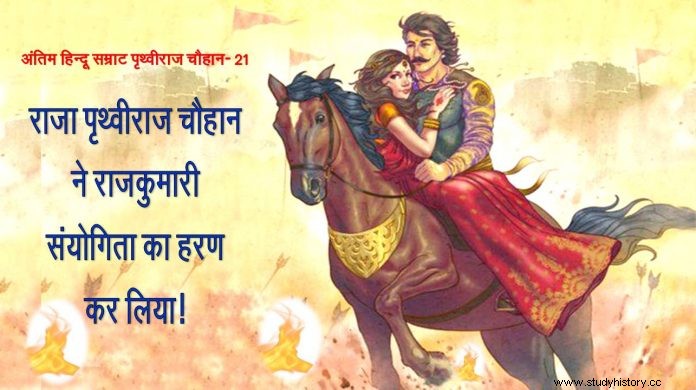
When Prithviraj Chauhan conquered Bundelkhand, the boundaries of Prithviraj's kingdom went to the Gahadwalas of Kannauj. Just as the Muslims in the west were the enemies of the provincial Chauhans, so in the north the Raja of Jammu, the Chaulukya rulers in the south, the Chandels in the east and the Gahadwals in the north-east were the enemies of the Chauhans.
When Prithviraj Chauhan defeated the Nagas, Bhandanakas, Chaulukyas and Chandelas, the jealousy of Chauhanraj was awakened in the mind of the ruler of Kannauj, Jaichand. According to some legends, one daughter of King Anangpal was married to King Someshwar of Ajmer, from whom Prithviraj Chauhan was born and the second daughter was married to King Vijaypal of Kannauj whose son was Jaychand. Thus Prithviraj Chauhan and Jaychand were cousin brothers.
Since Raja Anangpal of Delhi did not have any son, Raja Jaichand hoped that Jaichand would get the kingdom of Delhi, but Raja Anangpal Tomar gave the kingdom of Delhi to Prithviraj Chauhan. So Jaichand started having animosity with his cousin Prithviraj Chauhan and started looking for opportunities to humiliate him.
Poet Chand Bardai, author of Prithviraj Raso, has attributed the conflict between Chauhan and Gahadwal to Sanyogita, daughter of Jaichand. According to the description given in the Raso, Prithviraj Chauhan himself was not handsome, but he had a good sense of beauty. He married many beautiful women who were more than one delightful.
Hearing the tales of Prithviraj's valor, Jayachand's daughter Sanyogita accepted Prithviraj as her husband. When King Jaichand organized a swayamvar for Sanyogita's marriage, King Prithviraj Chauhan was not invited due to the already ongoing enmity and to humiliate him by making an iron statue of him, he replaced the gatekeeper outside the swayamvar-shala. erected.
Watch this interesting history video-
On this Princess Sanyogita sent a message to King Prithviraj that she wants to marry Prithviraj. On this, King Prithviraj reached Kannauj in disguise with his trusted followers. Princess Sanyogita, without worrying about her father's anger, put the garland of Swayamvara around the idol of Prithviraj.
King Prithviraj took away Sanyogita from the swayamvar-shala. The huge army of Kannauj could not harm him. Prithviraj's trusted and mighty feudatory and general kept fighting with the army of Kannauj so that King Prithviraj could reach Ajmer with Sanyogita. Many feudatories and generals of Prithviraj died after mole-mole to protect their masters. The king safely reached his capital Ajmer with his beloved.
The Prithviraj-Sanyogita episode has been given in the book 'Bitasahi's detail' in this way - 'Then King Prithviraj Sanjogata Parni. Jahi Raja Kaisa Kul Sola (16) Suri became 100. Have faith in yourself. Said the fight. Pani Raja Jaichand Pungalo is not worshipped. Intimacy happened. Be the king of Tahi. Only one hundred years old. Mahila Pandara Bara did not Neesario.'
This love saga of love, sacrifice and bravery has been depicted in a very beautiful manner in Prithviraj Raso. Well-known novelist Acharya Chatursen in his novel Purnahuti has written this love story in a very beautiful way, based on Prithviraj Raso.
While modern historians Romila Thapar, R. s. Tripathi, Gaurishankar Hirachand Ojha etc. have doubted the truth of this incident because the description of Sanyogita is not found in Rambhamanjari and in the inscriptions of King Jayachand. According to these historians, the story of Sanyogita is just the imagination of some 16th century Bhat. On the other hand historians like CV Vaidya, Dr. Gopinath Sharma and Dr. Dashrath Sharma have considered the incident of Sanyogita-haran to be correct.
Historians like Romila Thapar etc. misrepresent the story of Prithviraj-Syogita on the ground that Prithviraj's mother, Karpurdevi was the princess of Chedidesh and not of Delhi, whereas the Bhatons and Khyats have called Prithviraj as the daughter-in-law of Anangpal.
It is true that Prithviraj was not the grandson of Anangpal, but it is possible that there must have been some marital relationship between Achalraj, the Kalchuri king of Chedidesh and Anangpal, the Tomar king of Delhi, on the basis of which Prithviraj would have been considered a grandson of Anangpal of Delhi.
Secondly, Prithviraj was not the daughter-in-law of Anangpal, on this basis the story of Sanyogita is not proved wrong! If Prithviraj and Jaichand were cousins, Prithviraj would have been Sanyogita's uncle. In such a situation, the abduction of Sanyogita by Prithviraj would have been considered an immoral act. Therefore, since there was no blood relation between Prithviraj and Jaichand, there was no obstacle in Sanyogita Haran.
Therefore, there is no basis for considering the abduction of Sanyogita by King Prithviraj Chauhan as imaginary. Since the stories of Prithviraj's Queen Padmavati and Queen Ajiya being married to Prithviraj have included love stories, so the possibility of the incident of Sanyogita-Haran being historical increases. It is quite possible that King Prithviraj abducted Sanyogita and married her, so the writers of Charan and Bhat also coined the metaphor of love story in the context of Padmavati and Ajiya.
In essence, it can be said that Romila Thapar and his supporting historians have tried to prove the story of the abduction of Sanyogita by King Prithviraj Chauhan without any substantive basis.
Still, it is necessary that the reason given for the enmity of Prithviraj and Jaichand in Prithviraj Raso and other Bhat texts is wrong. Delhi was running under the Chauhans since the time of Chandanraj, son of Guvak II. Chandanraj had subdued Delhi by killing the Tomar king Rudrapal and the descendants of Tomar Rudrapal were appointed feudatories on behalf of the Chauhans on Delhi. In AD 1155, Vigraharaj (IV) defeated Anangpal, the Tomar king of Delhi, and again brought Delhi under the Chauhans. Therefore, Raja Jaichand did not have any claim on Delhi. This is just a figment of some of the fares.
See in the next story - the kings of India were fighting among themselves and the Turks were gaining foothold in India!
-Doctor. Mohanlal Gupta
